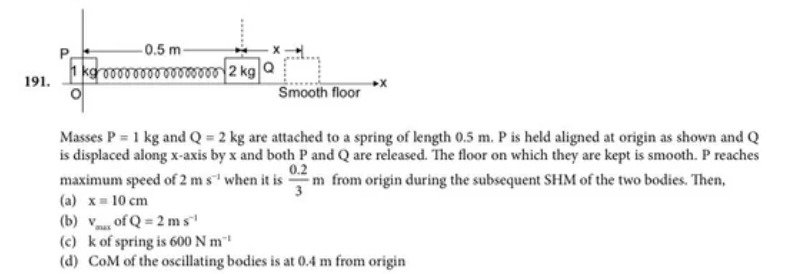Question
Question: Masses P = 1 kg and Q = 2 kg are attached to a spring of length 0.5 m. P is held aligned at origin a...
Masses P = 1 kg and Q = 2 kg are attached to a spring of length 0.5 m. P is held aligned at origin as shown and Q is displaced along x-axis by x and both P and Q are released. The floor on which they are kept is smooth. P reaches maximum speed of 2 m s−1 when it is 30.2 m from origin during the subsequent SHM of the two bodies. Then,

x = 10 cm
vmax of Q = 2 m s−1
k of spring is 600 N m−1
CoM of the oscillating bodies is at 0.4 m from origin
(a), (c), (d)
Solution
The problem describes a system of two masses P (1 kg) and Q (2 kg) connected by a spring of natural length l0=0.5 m, on a smooth horizontal floor. Initially, P is at the origin (x=0) and Q is at xQ(0)=0.5+x. Both masses are released from rest. Since there are no external horizontal forces, the center of mass (CoM) of the system remains at rest.
The initial position of the CoM is XCoM=mP+mQmPxP(0)+mQxQ(0)=1+21×0+2×(0.5+x)=31+2x.
Since the CoM remains at rest, its position is constant at XCoM=31+2x.
The equilibrium positions of P and Q are when the spring is at its natural length and the CoM is at XCoM. Let the equilibrium positions be xP,eq and xQ,eq.
xQ,eq−xP,eq=l0=0.5.
XCoM=mP+mQmPxP,eq+mQxQ,eq=1+21×xP,eq+2×(xP,eq+0.5)=33xP,eq+1=xP,eq+31.
So, xP,eq=XCoM−31=31+2x−31=32x.
And xQ,eq=xP,eq+0.5=32x+0.5.
The system undergoes SHM. The oscillation of each mass is about its equilibrium position. The speed of a mass in SHM is maximum at its equilibrium position.
We are given that P reaches maximum speed when it is at xP=30.2 m from the origin. This means that the equilibrium position of P is xP,eq=30.2 m.
Comparing the two expressions for xP,eq: 32x=30.2.
2x=0.2, so x=0.1 m = 10 cm.
Thus, option (a) is correct.
Now we can find the position of the CoM: XCoM=31+2×0.1=31+0.2=31.2=0.4 m.
Thus, option (d) is correct.
The oscillation of P is about xP,eq=30.2. The initial position of P is xP(0)=0.
The initial displacement of P from equilibrium is δxP(0)=xP(0)−xP,eq=0−30.2=−30.2.
The amplitude of P's oscillation is AP=∣δxP(0)∣=30.2 m.
The maximum speed of P is vP,max=APω, where ω is the angular frequency of oscillation. We are given vP,max=2 m/s.
So, 2=30.2ω.
ω=0.22×3=0.26=30 rad/s.
The angular frequency of oscillation for a two-body system connected by a spring is ω=μk, where μ is the reduced mass and k is the spring constant.
The reduced mass is μ=mP+mQmPmQ=1+21×2=32 kg.
So, 30=2/3k=23k.
Squaring both sides, 900=23k.
3k=1800, so k=600 N/m.
Thus, option (c) is correct.
Now let's check the maximum speed of Q.
The initial displacement of Q from equilibrium is δxQ(0)=xQ(0)−xQ,eq=(0.5+x)−(32x+0.5)=x−32x=3x.
Since x=0.1, δxQ(0)=30.1 m.
The amplitude of Q's oscillation is AQ=∣δxQ(0)∣=30.1 m.
The maximum speed of Q is vQ,max=AQω=30.1×30=0.1×10=1 m/s.
Thus, option (b) is incorrect.
The correct options are (a), (c), and (d).
Explanation of the solution:
- Identify that the system is of two masses connected by a spring on a smooth surface, so the center of mass remains at rest.
- Calculate the initial position of the center of mass.
- Determine the equilibrium positions of the masses, which are located such that the spring is at its natural length and the center of mass is at its initial position.
- Recognize that the maximum speed of a mass in SHM occurs at its equilibrium position. Use the given information about the position of P when its speed is maximum to find the equilibrium position of P.
- Equate the two expressions for the equilibrium position of P to find the value of x.
- Calculate the position of the center of mass using the value of x.
- Calculate the amplitude of oscillation for P from its initial displacement from the equilibrium position.
- Use the given maximum speed of P and its amplitude to find the angular frequency of oscillation.
- Use the formula for the angular frequency of a two-body system with a spring and the reduced mass to find the spring constant k.
- Calculate the amplitude of oscillation for Q from its initial displacement from the equilibrium position.
- Calculate the maximum speed of Q using its amplitude and the angular frequency.
- Compare the calculated values with the given options.
